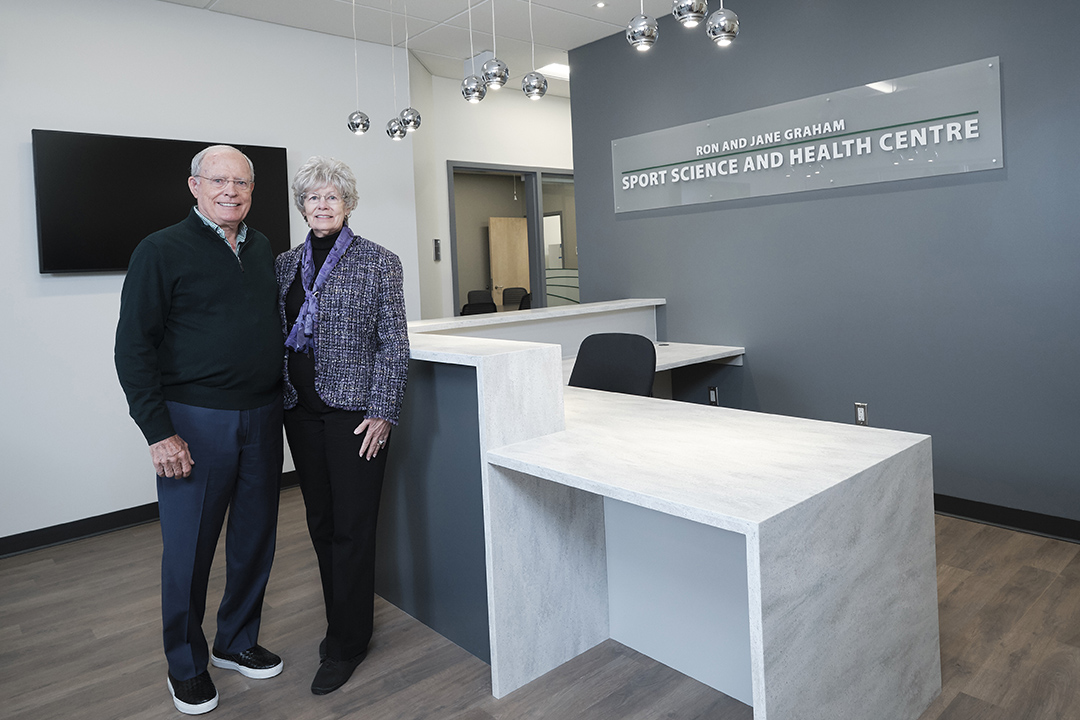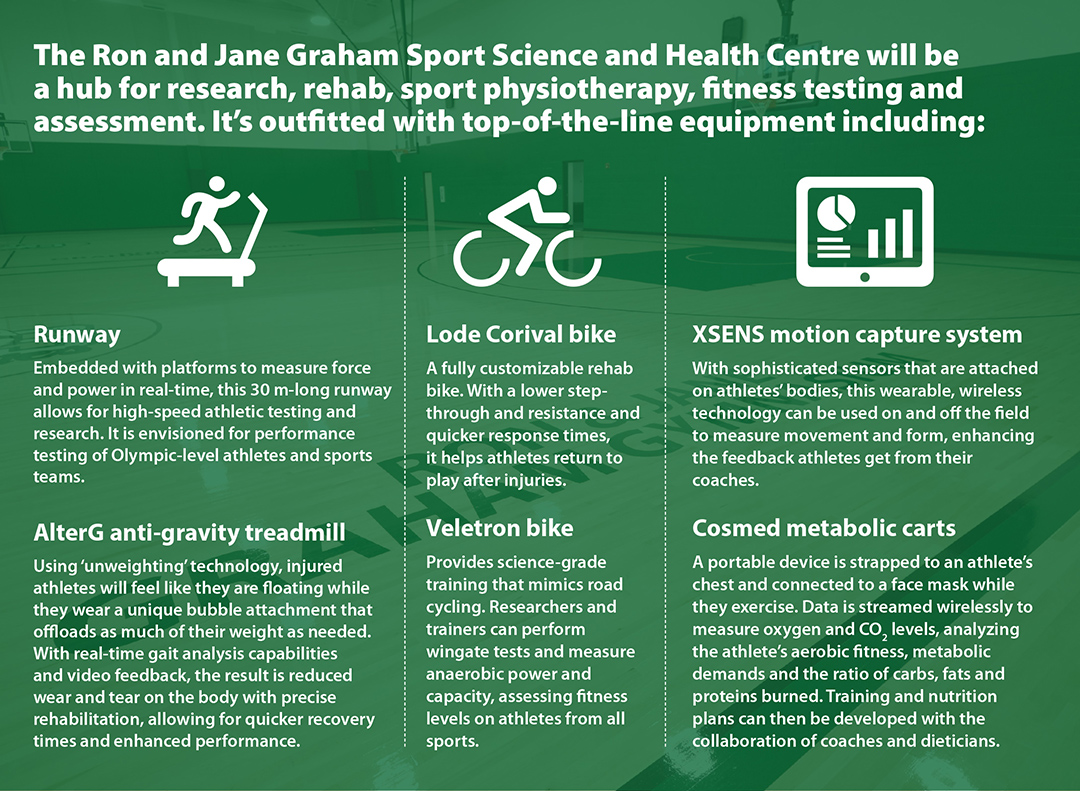
High-tech hub
Saskatchewan athletes are getting the leg upon their competitors, thanks to an innovative sport science and health centre that opened in Merlis Belsher Place.
By Jessica ElfarThe new Ron and Jane Graham Sport Science and Health Centre is ready to serve athletes from the Huskies and across the province, and will open up services to the greater Saskatoon community in the spring of 2019. The facility will be a hub for researchers, physiotherapists, dieticians, mental health professionals, sport psychologists and trainers to help athletes return to play sooner after injury, engineer new approaches to concussion treatment, and give Huskie student athletes access to leading sport science technologies.
Ron (BE’62, DCL’13) and Jane (BEd’62) Graham, the long-time donors that funded the project with a $2.068-million gift, toured the space in March just as the final touches were taking place. They said they were excited to see the dream of the new high-tech centre come to fruition, just one year after their donation was announced.
“Seeing the interview areas, the research areas, the physio areas— it’s really happening!” said Jane, who emphasized that the centre is not just focused on athletes’ physical health; it looks at mental health as well. “It covers the whole person,” she said.
Ron said he is pleased to see the progress on the new research and rehab centre because of what it means for athletes in regards to sports injuries, both at the university and around the province.
“On a long-term basis the research will be important to help athletes with prevention—so there won’t be as many injuries happening in the first place. That’s what’s key,” said Ron.
The couple said their wish is that student-athletes will now leave the university after graduation healthier than when they arrived. They were motivated to help when they noticed the increase in athletic injuries at all levels of sport and hearing of the university’s desire to increase research into the area.
The Grahams were both Huskie athletes during their time as students, so they understand the nature of sports injuries first-hand. Jane competed on the varsity swim team, and Ron was a basketball player and football quarterback. “Athletic injuries can stay with you a long time—it could be a bad knee or, in my case, it was ankles. I sprained them continually,” stated Ron, who said he suffered from his injures for years after he played.
Preventing and treating injuries will be priorities of the new centre, using highly-specialized equipment. Sean Maw, the Jerry G. Huff Chair in Innovative Teaching in the College of Engineering, helped design one of the most unique features in the new centre— a two-story ‘dropzone’—to study and reduce concussions for athletes in high-impact sports. He said this is not only an exceptional asset for a Canadian sport science centre, but it’s world-leading because of the design and the capabilities to look at the impact on the athlete’s whole body.
“Not a lot is understood about impact and concussions, so it’s an exciting time to be looking at some of these things,” Maw noted, adding that it’s a misconception that helmets prevent concussions. “Helmets help prevent severe head trauma. But we don’t understand concussions well enough to know the criteria of what causes them and what reduces them.” He’s hoping to change that with the new research capabilities of this centre, which he describes as cutting-edge.
Dr. Joel Lanovaz (BE’90, PGD’92, MSC’97, PhD), associate professor in the College of Kinesiology and biomechanics researcher, said the collaborative nature of the space is what’s most appealing.
“It’s nice having everyone in one spot—researchers, physiotherapists and athletes—it leads to more collaborations,” said Lanovaz. Colleges and programs involved in the project are wide-ranging, including kinesiology, Huskies, medicine, pharmacy and nutrition, and engineering, among others.
In addition to interdisciplinary academic research, Lanovaz said he’s hopeful the space will also lead to breakthroughs for student research.
“I have one master’s student, Nicolas Hallgrimson, who is also a gymnast. He’s studying how the forces of takeoff during a ‘salto’—an aerial summersault—will impact landings. For example, if they are asymmetrical at takeoff, will they be asymmetrical in their landing?” He noted that studies like this could help change how training plans are made for athletes, but the sky is the limit for potential outcomes of the space.
Additionally, Lanovaz noted that Olympic-level athletes will benefit from the performance testing available in the space, citing Keely Shaw (BScKin‘16) as a great example.
“She’s a world-class Paralympic cyclist, who would typically need to fly to Montreal for some of her athletic testing. Now she can do those tests in this centre,” said Lanovaz.
The student-athlete experience is paramount to the Grahams, who said they continue to give back so that USask students enjoy university fully and become better citizens when they graduate. The couple has given more than $22 million to support USask students, athletes and academics, including $4 million to open two additional practice courts in Merlis Belsher Place for Huskie basketball teams, ensuring they have ample practice space.
“They are such amazing young people! And we just feel so proud of what they’ve accomplished, and the experiences they’ve had. It’s keeping us young!” said Jane.


